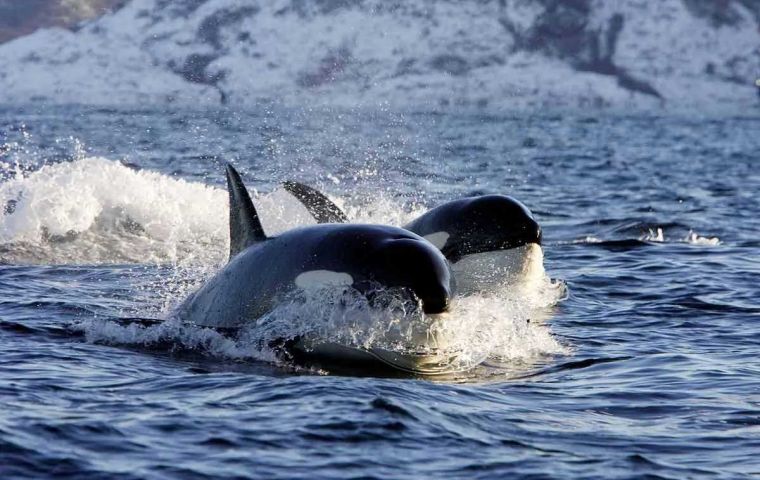MercoPress. South Atlantic News Agency
State of Cetaceans 2024, ORCA report in oceans worldwide
 Many 2023 findings are from the Southern Ocean survey undertaken by ORCA, the Government of South Georgia, and the British Antarctic Survey
Many 2023 findings are from the Southern Ocean survey undertaken by ORCA, the Government of South Georgia, and the British Antarctic Survey  Findings discovered that humpback whales near the Antarctic Peninsula were present in far higher numbers early in the season than anticipated.
Findings discovered that humpback whales near the Antarctic Peninsula were present in far higher numbers early in the season than anticipated. Marine Conservation Charity ORCA’s “State of the Cetaceans 2024”, (*) report is a fascinating glimpse into how the world’s whales and dolphins are coping with human impacts on the ocean. It analyses the extraordinary 330,000 kilometers of marine surveys conducted by ORCA in 2023, recording 55,604 whales and dolphins in oceans worldwide from the Arctic to the Antarctic, the North and South Atlantic, and the Pacific to the Mediterranean.
Data gathered during ORCA surveys in UK waters since 2017 has now been analyzed and reveals a distinct increase in common dolphin sightings in the English Channel and Hebrides and a parallel decline in white-beaked dolphins in the Hebrides. This is likely associated with increased sea temperatures and shifts in prey distribution, resulting in white-beaked dolphins moving to their favored colder waters and common dolphins becoming more at home in the warmer UK waters.
Many of the 2023 findings are new insights that will inform decision-making on conservation measures globally. These include the findings from an ongoing Southern Ocean survey undertaken by ORCA, the Government of South Georgia and the South Sandwich Islands, the British Antarctic Survey and HX. This discovered that humpback whales near the Antarctic Peninsula were present in far higher numbers early in the season than anticipated. The waters around Elephant Island are becoming a hotspot for fin whales.
ORCA CEO Sally Hamilton said; “Many of these new insights have only been revealed thanks to the patient dedication of ORCA’s growing army of citizen scientists. And as our global reach expands, so their impact increases, as they throw light on so much that is either unknown or understudied about our precious marine environments.”
State of Cetaceans highlights.
The sea regions surveyed during 2023 included the Arctic Ocean, Northeast Atlantic Ocean, Mediterranean Sea, western North Atlantic Ocean, South Atlantic Ocean, Southern Ocean and Pacific Ocean.
ORCA’s evidence collection, in the form of ongoing sightings recorded by Marine Mammal Surveyors from ferries traversing the Bay of Biscay, North Sea, English Channel, Hebrides and Celtic Seas, provided compelling data to inform the creation of 33 new Important Mrine Mammal Areas, (IMMAs), in the Baltic and Northeast Atlantic.
Further ship strike behavioral work continued in the Bay of Biscay on board a ferry with recordings of fine scale behaviors of close encounters with whales. Findings included recordings of multiple near-miss events with fin whales and Cuvier’s beaked whales. The observed fin whales tended not to react to the ship’s presence.
High rates of fin whale sightings were observed southeast of Greenland, south of Iceland and to the northwest of the Iberian Peninsula. Additionally, a clear hotspot emerged in the deep waters of the Bay of Biscay during the summer months.
Minke whale sightings were concentrated in shallower, coastal waters in the Celtic Sea, western English Channel and around Iceland, Norway and Greenland. The highest sighting numbers however were in the northwestern North Sea and the Hebrides.
Beaked whales - From ORCA’s 2023 dataset, unidentified beaked whale sightings rates were high in the canyons of the Canadian continental slope, off the northwest corner of the Iberian Peninsula and around Eastern Atlantic islands of the Azores, Madeira and the Canary Islands and in the submarine canyons of the southern Bay of Biscay. This is consistent with previously identified important beaked whale habitat.
Hotspots for Cuvier’s beaked whale sightings were also observed on the shelf edge of the Armorican shelf and in the Alboran Sea in the Mediterranean Sea. This coincides with the Alboran Deep Important Marine Mammal Area (IMMA) which was designated in part as an important habitat for Cuvier’s beaked whales which are present in this area in high densities every season.
(*) The annual State of Cetaceans report (SOC) is a respected and authoritative snapshot of whale and dolphin populations, compiled from tens of thousands of kilometers of survey effort collected by our volunteer Marine Mammal Surveyors workforce and in-house Cocean Conservationists. The global sea regions surveyed include the Atlantic, Pacific, Arctic and Southern Oceans and the Mediterranean Sea.




Top Comments
Disclaimer & comment rulesCommenting for this story is now closed.
If you have a Facebook account, become a fan and comment on our Facebook Page!